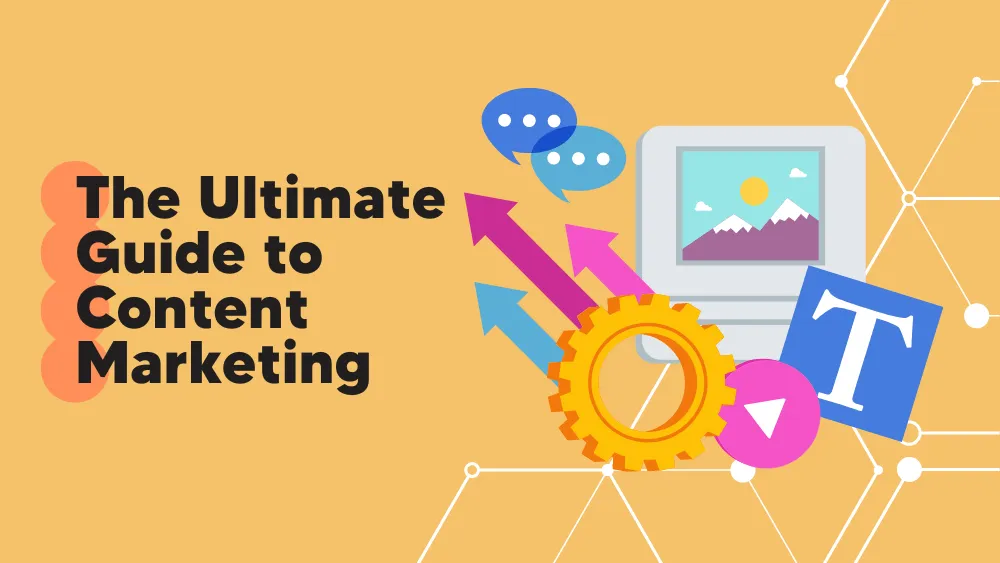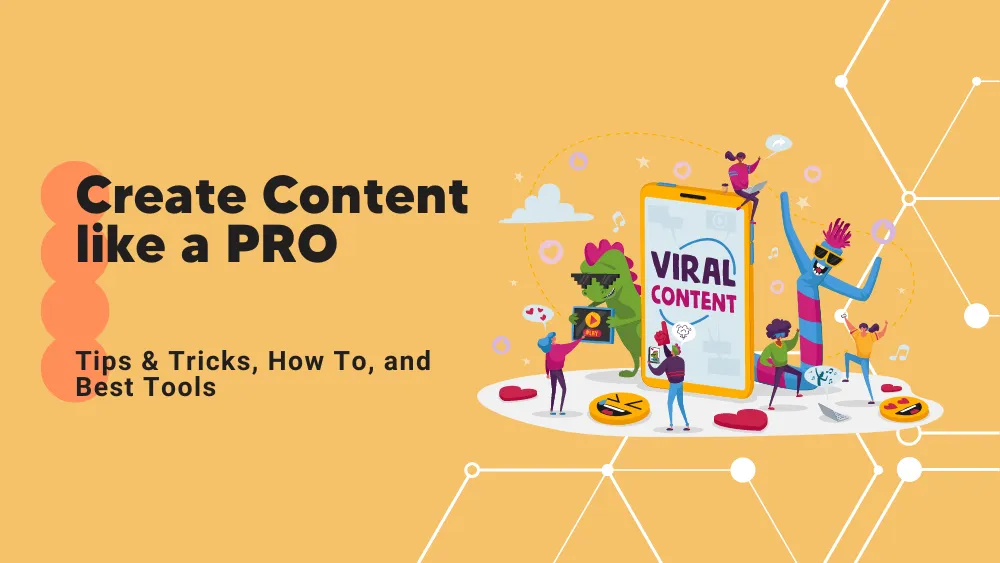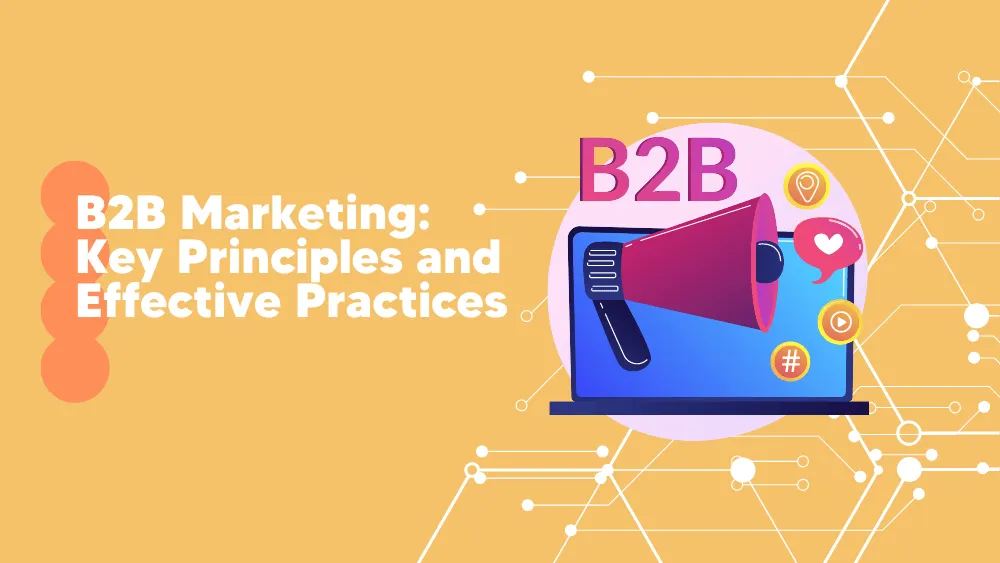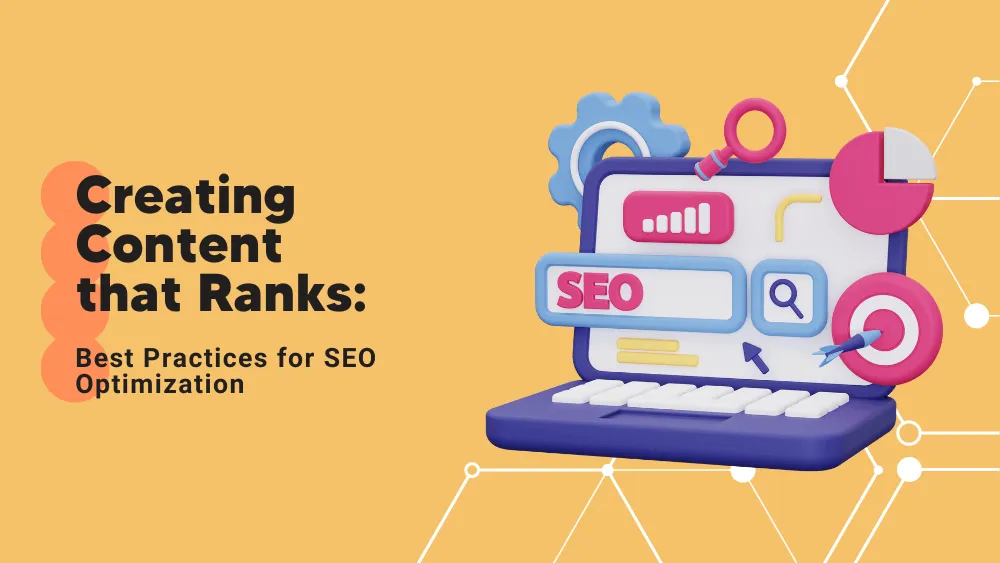Content marketing is the bee’s knees, the cat’s meow, the…you get the picture, it’s essential. But in all seriousness, there’s a reason we see examples of content marketing pretty much everywhere we look – it works. It’s the life of the party in the marketing world, shaking things up with its contagious energy and irresistible charm. It’s a way to get your audience to stop scrolling by providing something interesting that emerges from a sea of monotony.
When you’ve got content that’s more entertaining than a kitten playing with a ball of yarn, people can’t help but notice. It’s a complex craft, but it’s worth the hassle. What exactly does the hassle entail? – That’s exactly what I’m about to explain.
What is Content Marketing?
We know it’s great, but what is content marketing? There isn’t a simple, agreed-upon definition of content marketing because it can be many different things. In general, it’s the mysterious practice of crafting content that people want to consume in the hope that an audience interested in your offer will come. It’s a nice change from adverts popping out of the blue and spam clogging our inboxes.
You may have noticed I’m using the word content, which covers almost everything you can find online. Well, it fits. Everything is pretty much what content marketing focuses on, from videos to podcasts to articles to memes. The key is to find the type that resonates with your audience and makes them say, “Hey, I want more of that!” in the hope that someday they’ll say, “Hey, I want to give money to this company!”.
Let me give you a few examples to help you visualize it better. Say you’re a fashion brand trying to reach a younger audience. You might create a series of TikToks, irreverent videos featuring influencers wearing your clothes and dancing to a catchy tune. If you’re a B2B software company trying to establish thought leadership in your industry, spending time creating TikToks may be a slightly worse idea. Instead, in that case, you might create a series of in-depth blog posts or articles that explore the latest trends and challenges in your field.
The bottom line is that content marketing is about making stuff for your audience. You’ll build a relationship with them by giving them informative, entertaining, or just plain interesting content. You won’t be simply a buyer and a seller. And when the time comes for them to make a purchase, you’ll be top of mind.
Importance of content marketing
Content marketing is important, and people have grown to expect it. It’s not just a buzzword or a passing trend but a necessity, that is, if you want to reach and engage with customers. The truth is that people are bombarded with noise these days and have become used to filtering it out and only paying attention to those things that are in some way valuable to them. You want to cut through the noise, but catching their attention is like trying to make a toddler focus on an English lesson; you have to do it by creating something that resonates with them.
Regardless of the size or industry of a company, it will need similar content marketing tools, as people are pretty much the same on this level – they expect to be interested or entertained. A study conducted by Havas Group in 2017 found that 84% of consumers expect brands to come up with content, and they don’t want the bad kind– 60% of subjects complained about the quality of the one they could see.
Benefits of content marketing
Content marketing isn’t just a necessary evil and a struggle businesses must face to exist online. When done right, it can be quite an enjoyable experience for both parties – an experience that changes the regular seller-buyer dynamic because you’re not just trying to sell something. Instead, you’re building a relationship with the audience, engaging with them, and offering them value beyond just your products or services, which pays off in various ways.
People rarely chat about advertisements or the type of software they use. Still, when you publish something they appreciate and find valuable, they are likelier to talk about it or even share it with their friends and followers on social media. That’s exactly what you want, leading to more exposure for your brand and more potential customers asking you to show them what you’ve got.
One thing leads to another, and before you know it, all the talk and sharing create more traffic, which causes the search engine rankings to skyrocket. By consistently producing high-quality content relevant to your industry, you can boost your website’s SEO and appear higher on search engine results pages. This means that when people search for products or services you offer, your website will be more likely to appear. All that without paying for costly campaigns and advertising space (or at least paying less).
Types of content marketing
The world of content marketing is a world of endless possibilities. While it is true that crafting consistent, high-quality content is the priority, it also needs to be tailored to the audience, like a piece of clothing. Promoting a SaaS software company with a series of goofy videos, no matter how well made, maybe like trying to wear a tuxedo to a backyard barbecue – it’s just not the right fit for the occasion.
Unlike with clothing, though, there is no limit regarding the number of different forms that can be used to engage the same audience. A simple energy drink company can go as far as to create a wide range of content: videos, podcasts, and even special events.
Blog Posts
If you want to craft an amazing blog post, know your audience first. Before you even start writing, it’s important to understand who you’re writing for clearly. What do they care about? What are their pain points? Maybe, what topics and kind of tone do they prefer? Or what makes them laugh? Are they afraid of spiders? Once you know it all – proceed. The first thing your audience is going to see is the headline. It should be clear, concise, and catchy, with a promise of delivering value but on par with what you are about to deliver.
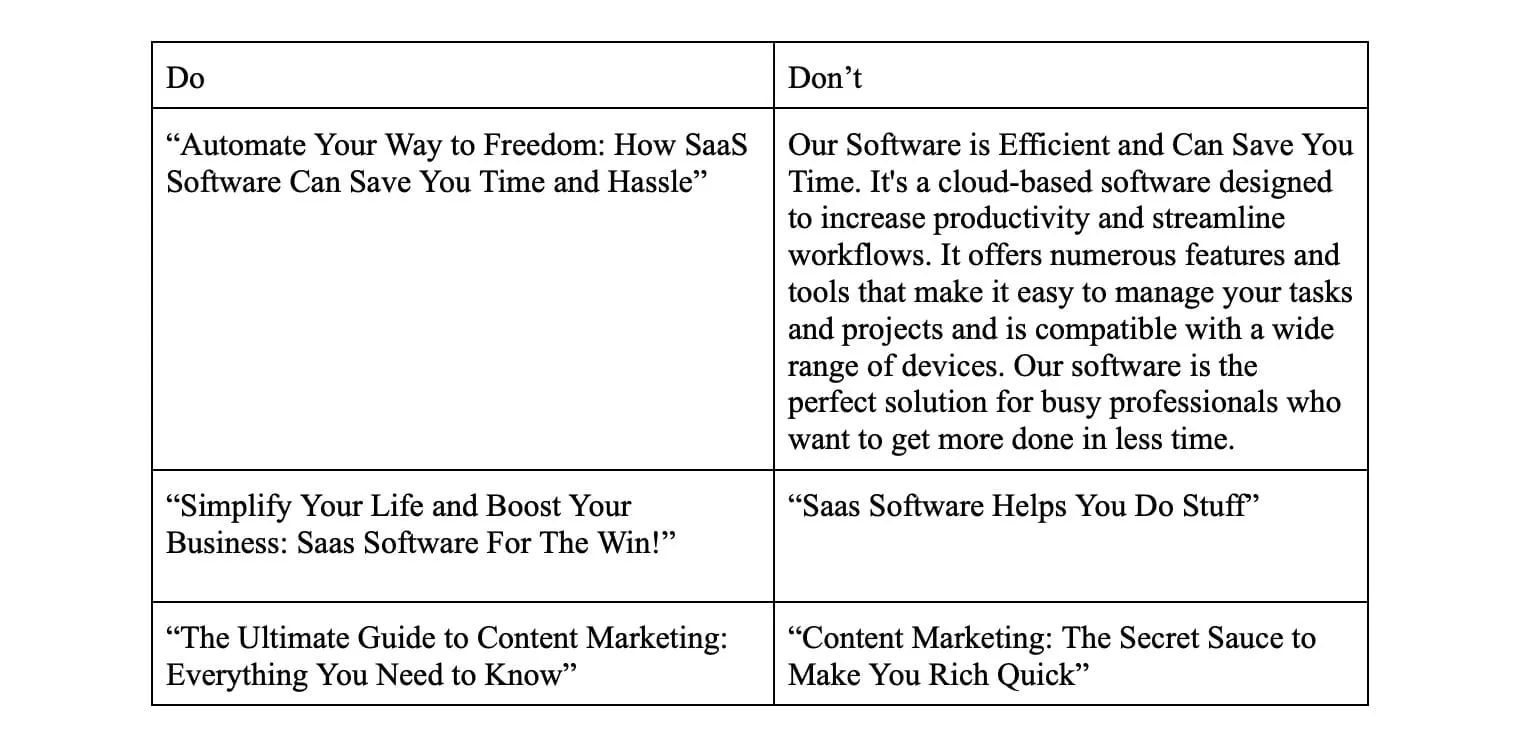
Moreover, use subheadings and formatting to break up your blog post into smaller, scannable chunks. This makes it easier for your audience to read and digest your content and improves your post’s SEO. Here it’s much easier to use proper content marketing tools than try to do it all yourself. Software like Surfseo or Semrush will consider much more data than any human ever could.
Lastly, don’t forget to promote your posts! Even the best blog post won’t generate traffic and engagement if no one knows.
Infographics
To create an effective infographic, there are a few key elements to take care of. Before you start, it’s important to choose a topic that is relevant to your audience and that you can present visually appealingly. This might mean using colorful charts and graphs, incorporating images or icons, or presenting information uniquely and creatively. Just as if you were trying to interest a child.
It can’t be too cluttered, though. Infographics should tell a story, with each section connected to the previous one or the overall idea. Use headlines, subheadings, and images to break up the information and guide the reader through the content.
In design, keep things light and breezy; you don’t want them to go too hard on the eyes. Use a consistent color palette and font style and avoid ruining the design with too much information. Finally, don’t forget to add your branding. This can include your logo, website URL, and social media handles – just in case it got lost somewhere on the internet.
Check these Visme infographic templates for some examples and inspiration.
Videos
Videos have become increasingly popular in digital content marketing. For good reasons, they are one of a few ways to put a face on a brand, connect with your audience, and showcase your brand’s personality.
It does sound like a cliche, but everything is fast-paced nowadays. For this reason, viewers are unlikely to sit through lengthy videos, so it’s best to start with short ones and gradually build their trust. Once they realize that you provide them with interesting content, they will return for more and may even be eager to watch longer ones. The script of the video is not all, though. While you don’t need a Hollywood-level budget to create engaging videos, it’s important to ensure that your videos are well-lit, well-framed, and that the audio is clear.
Most of the time, the title and thumbnail are just as important as the content itself. Your title should be clear and descriptive, giving viewers a good idea of what’s to come. Avoid using clickbait titles that overpromise and underdeliver; you want people to return! The thumbnail should also be eye-catching and relevant to the video’s content. A good one is an invitation for viewers to click and watch, while a bad one is a turn-off. Make sure it accurately represents your video, and use design elements like bold text and bright colors to make it stand out.
E-books and whitepapers
E-books and whitepapers can set your brand apart from the competition, showcasing your knowledge and establishing you as a thought leader in your industry. Although creating them can be daunting, it is worth your while. You wouldn’t write a book about it if you weren’t an expert, right? That’s exactly what people are going to think.
I can’t stress this enough: Don’t be boring; almost everyone else is. Instead, approach your piece like a story or a conversation. You want to take your readers on a journey and talk to them while presenting your insights and ideas. Make it relatable, use anecdotes and examples, and don’t be afraid to inject your personality into it. Sophisticated language is great, but on essays. Avoid using words you wouldn’t think of during a chat with your friend.
Of course, it’s not just about the writing. The design, including the layout, images, and typography, can be as important as the words. Sharing and promoting it via various platforms won’t hurt too.
Case studies
Case studies are like the proof in the pudding, the cherry on top of the cake, or the bacon on your burger. They provide real-life examples of how your products or services have helped others and can be a powerful tool for demonstrating their effectiveness to potential customers.
Not all case studies are created equal, though they require some effort to attract attention. Enough, you need a customer who has seen tangible benefits from your product, which you will focus on. When you have all that, nothing is left to do but create a compelling narrative. It’s a story, so write it as such; I highly discourage any postmodern approach; it’s better to make the beginning, middle, and end clear and follow the timeline.
Also, remember that “’Grown-ups are very fond of numbers,” so put a few of them on the way.
Any obstacles encountered during the process are also a nice addition. Including them in the case study can show people you’re honest and unafraid of challenges.
Webinars and podcasts
We’ve grown to love webinars and podcasts, especially after the memorable time of on and off lockdowns. They offer an opportunity to connect with your audience on a deeper level, sharing knowledge and expertise in a conversational format. Sadly, creating an engaging webinar or podcast requires more preparation than just turning a webcam, or a microphone, on.
Assuming you already have the right topic and guest(s) in mind, the first step is establishing a structure. Naturally, the digressions are welcome, but it’s nice to have a backup plan in case you can’t improvise anything interesting on the spot. Regarding webinars, it’s important to keep the visuals interesting and engaging. Incorporating slides, graphics, or video clips can help to break up the presentation and keep your audience’s attention.
For podcasts, the focus should, for obvious reasons, be on the quality of the audio. Invest in a good microphone and ensure the sound quality is clear and consistent throughout the episode. Besides, nothing is left to do but be (or have) a good host. This means someone personable, engaging, and able to ask insightful questions that prompt discussion and debate.
Create a SaaS Podcast
Social media content
With 4.76 billion (59.4% of the world’s population) people using social media for 2 hours and 31 minutes a day on average, you want them to be looking at your pages. However, with so many types of social media content out there, it can be challenging to know where to start. Well, it involves a mix of all the types of content I’ve mentioned before, with some new additions:
- Images: A great way to grab attention and convey a message quickly. Use high-quality visuals that align with your brand’s aesthetic and personality.
- Videos: Offer a more dynamic way to engage your audience, whether it’s through product demos, customer testimonials, or behind-the-scenes glimpses of your company. Keep them short and sweet, ideally under 2 minutes, and optimize for mobile viewing.
- Live streams: Provide an authentic way to connect with your audience in real time, allowing for Q&A sessions, interviews, and live events. Be sure to prepare as much as possible, promote your live stream in advance, and engage with viewers during the broadcast.
- Gifs and memes: Add humor and personality to your content, making it more relatable, shareable, and probable to go viral. Here, you must pay attention to your brand’s tone and message and avoid offensive or insensitive content. We know it´s a joke; someone can have a different idea.
- Polls and quizzes: Encourage audience interaction and provide valuable insights into their preferences and interests.
- Text Posts: A powerful tool for sharing information, opinions, and stories with your audience. To make the most of them, keep them short and easy to read, use eye-catching headlines, and maybe even include a clear call-to-action at the end.
Above all, though, you should want to be consistent. Whatever you’re posting, develop a content calendar or schedule to help you stay on track and plan. Social media algorithms love consistency.
User-generated content
Sometimes it’s nice to kick back, relax and have someone do things for you. Why would you generate all the content about your brand when your army can do it for you? That’s the beauty of user-generated content (UGC).
The most difficult aspect here will be the start; at this point, you already need some followers you’ll guide in the right direction. You can do it by offering encouragement to create and share content about your brand. It could be a discount, a freebie, or good old-fashioned recognition. Go wild with it!
One more thing you may want is a catchy branded hashtag that will not only be used with posts about your brand on social media but will also make it easier to track and curate the content and help your followers feel like they’re part of something bigger than themselves. Don’t forget to show them some love, respond to their posts, share their content, and give them a virtual high-five just for being awesome. Then, you can lay back and enjoy the process.
Email newsletters
Email newsletters are a great way to stay in touch with your audience, keep them updated, and remind your subscribers that you still exist.
Avoid putting up a wall of text there. That’s not what people want to see. Make sure your newsletters are visually appealing and easy to read. Images, clear headings, and short, snappy copy are all there to help keep your audience engaged and interested.
Personalize your content and segment your audience. Use data to understand your subscribers’ interests and preferences and tailor your content to their needs. And don’t forget to use personalization techniques like using the recipient’s name in the email or sending targeted content based on their past behavior.
Last but not least –be consistent with your newsletter schedule. Nobody wants to play “Where’s Waldo” with your emails! So, keep your newsletters regularly, whether sent out weekly, biweekly, monthly, or every century.
Content marketing vs. Advertising
Picture this: you’re scrolling through your social media feed and seeing an ad. Anger, boredom, and helplessness all flow through you simultaneously. But then, you see a post that catches your attention – it’s funny, informative, maybe even a little weird, and above all, doesn’t try to sell you something (at least directly). You can’t help but click it –that’s the power of content marketing!
Conventional marketing makes you throw enormous amounts of money down the drain while creating nothing significant. At the same time, content marketing is all about value. It’s not something that you scroll, skip, and forget, something that leaves the target audience with a sense of frustration and even hostility towards your brand; it’s the complete opposite.
Instead of using psychological tricks to make people buy your stuff, content marketing is an attempt to be their buddy, a go-to source of wisdom they trust their money with. Not a single ‘no’ will have to be taken for an answer if there are no questions.
Developing a Content Strategy
As the old saying goes, “If you fail to plan, you plan to fail,” and content marketing is not an exception. Without a solid content marketing strategy, you risk not resonating with your audience, thus aligning with your business goals, thus just falling flat.
So, how do you create a good content strategy? Here are some key steps to consider:
Setting goals and objectives
Let’s start from the top, shall we? You need to know where you’re going and how you will get there. So, to set clear goals and objectives for your content marketing campaign, you need to figure out what you want to achieve as a business and how your content marketing can help you get there.
Then, choose specific, measurable goals, and track your progress using KPIs (Key Performance Indicators), which is a way to measure and track how well your content marketing is doing using specific metrics like website traffic or social media engagement.
Identifying your target audience
When it comes to content marketing, it’s important to know who you’re trying to engage – just like when making a road trip mixtape. Identifying your target audience starts with understanding who your product or service is designed for and what problems it solves. This includes considering age, gender, location, interests, and behaviors.
Once you’ve done it, you know who you want to impress with your content, but do you know them? To get to know your target audience better, create buyer personas. These complex, fictional characters represent different types of customers within your target group. Think of them as your audience BFFs. You can include stuff like age, gender, hobbies, fears, and desires, or whether they like pineapple on pizza or not. Surveys, interviews, or analytics are there to help you with it.
Conducting keyword research
Using the right words to ensure the right people find your content would be best. You can use tools like Google Keyword Planner or SEMrush to find the best keywords to see what people are searching for. Just be careful not to use too many of them, or your content will sound weird. If done well, more people will visit your website as search engines will be your friends.
Developing buyer personas
Let’s get back to our audience, BFFs; as your content marketing campaign moves forward, the goal is to continually refine and update your existing personas with new insights and data. As your business and industry evolve, so will your understanding of your target audience, their behaviors, interests, and challenges. , keep up to date; people grow up, and so should buyer personas.
Creating a content calendar
Treat the future you as a friend – what does it mean exactly? Think ahead, and don’t scramble to develop new ideas at the last minute. With content and an editorial calendar, you can easily visualize your pipeline and keep track of important dates and events.
One way to do it is to start by defining your content goals and themes for each month or quarter. Then, determine the types of content you want to create, such as blog posts, social media updates, or videos, and brainstorm ideas for each one. From there, create a schedule and assign tasks to team members or yourself to ensure content is consistently produced and published. Don’t forget to leave room for flexibility and adjustments as needed.

Measuring and analyzing results
If you’ve been creating amazing content for quite some time now, it’d probably be great to know if it’s working. Measuring the success of your content marketing efforts is crucial in determining what’s working and what’s not, but what exactly is the gauge here? Is it more likes? More shares? More conversions?
It can be hard to tell. That’s why it’s best to look from a wider perspective and mainly at the things that matter the most – so-called key metrics. Don’t worry if it sounds like magic at this point; the specifics will be explained later and in more detail. Aside from website analytics, there are different actions to be taken, such as:
- Controlling social media engagement: Yes, the likes, comments, and shares of your social media posts, videos, etc., can be one of the indicators for you to keep up the good work. They can help you gauge the engagement and interest your content generates among your audience. If something is more popular, do more of that.
- Checking email open rates: If you’re sending out newsletters or other email marketing materials, track how many people are opening and engaging with your emails. This can give you a good sense of how well your messaging is resonating with your subscribers.
- Conducting surveys and customer feedback: Talk to people and ask what does it for them and what doesn’t. They are not your content writers; they have no reason to lie.
Keep in mind that the content marketing strategy is not set in stone. It can (and should!) be changed if such a need arises.
Promoting Your Content
If no one sees your content, does it exist? It sounds like an old Buddhist riddle, but it is a valid question. You can spend hours crafting a piece of content, beautiful and perfect in every aspect, and still end up with it, never seeing a pair of eyes. Without proper promotion, even the best piece can go unnoticed in the vast ocean of information available online. It’s like throwing a surprise party and forgetting to invite anyone. So, how to invite people to the party?
Email marketing
We don’t want to become what we’re trying to fight, so let’s not try to be too pushy. People’s inboxes are already crowded. Instead, and I will be saying it yet again, provide value. Try to include some helpful tricks there, maybe some news and updates – pretty much anything that doesn’t look like spam and that you’d like to see in your inbox.
After all, you’re starting a conversation with someone. Whether it’s your first chat or you’ve known them for a long time, you want to ensure they feel they’re getting something worthwhile from you.
Influencer marketing
Let’s face it, recommendations from the right people can take you far, even if you pay for them. Use this to promote your content but don’t close your eyes and point at an influencer you will choose for this task. You need to make sure they share your values, have a genuine connection with their followers, and, most importantly, are willing to collaborate with you.
Once you’ve identified potential partners, send them a personalized message highlighting why you think they would be a good fit for your brand and what you can offer them in return. Remember, building a genuine relationship with your influencer partners and working together to create content that will make waves is important.
Paid promotion
Many promotions can be done free of charge, but sometimes you have to spend money to make money. Google Ads, for example, is a great way to reach your target audience. By bidding on specific keywords related to your content, you can ensure that your ads appear at the top of search engine results pages, leading to increased visibility and traffic to your site.
Social media advertising is another option, with most offering highly targeted ad options that allow you to reach specific demographics, interests, and behaviors. From sponsored posts to carousel ads and video ads, it offers a range of options to promote your content and reach a wider audience.
Analyzing and Improving Your Content Marketing Efforts
Setting up analytics might sound daunting, but it’s not rocket science. It’s more like building a puzzle with a manual. After all, the analytics tools aren’t here to make your life harder, and most of them work similarly. Allow me to explain the process on the example of the Google Analytics Tool:
- Create a Google Analytics account if you haven’t already done so.
- Install the tracking code on your website or blog.
- Set up conversion goals in Google Analytics to track specific actions you want your audience to take, such as filling out a contact form or purchasing.
- Use UTM codes to track the performance of your marketing campaigns across different channels, such as social media, email, and paid advertising.
- Use Google Analytics reports tracking key metrics, such as page views, bounce rate, time on site, and conversion rate.
- Analyze your data regularly to identify patterns, trends, and areas for improvement in your content marketing strategy.
- Adjust your content strategy based on your analytics data to optimize your results.
Identifying key metrics
When you install one of many analytics tools available, there will be much to look at. That’s why, to avoid losing yourself in all this data, it’s important to identify key metrics relevant to your specific goals and objectives. Here are some of the most important ones:
- Engagement: As mentioned earlier, it measures how people are interacting with your content, such as likes, comments, shares, and time spent on each page. The more of it you have, the more interested and connected with the audience you have.
- Website traffic: How many people are visiting your website, how long they stay, and which pages they visit the most. This can give you insights into what content is most popular and what areas of your website may need a bit of polishing.
- Conversion rates: Ultimately, content marketing aims to drive conversions and generate leads. Keep track of how many people are taking action on your website or landing pages, such as filling out a form, making a purchase, or subscribing to a newsletter. This can help you understand your content marketing efforts’ ROI (Return On Investment).
- Click-through rates (CTR): This measures how many people are clicking on a specific link or call to action in your content. A high number means your content is doing a good job of getting people to do what you want them to do.
- Bounce rate: This measures how many people leave your website after viewing only one page. If it’s high, it might mean that what people find after entering disappoints them.
A/B testing
Essentially, you create two versions of the same piece of content – A and B, with one or more variations between them, ideally, not too many. Then, you show each of them to a randomly selected portion of your audience and collect their responses. Just like that, you get to know which headline, call to action, layout, or whatever you want to compare is better.
Make sure you have two things, though: a clear idea of what you’re testing and what you hope to achieve (Are you trying to increase engagement, conversions, or something else?) and a large enough sample group.
Adjusting your strategy
So, we’ve got all these fancy tools to measure the success of your content marketing efforts, and you’ve been running some A/B tests like a mad scientist. Still, all of that – the analytics, the feedback-collecting, and testing was done for a reason – to help you adjust your content marketing strategy. So how to do it?
First, don’t panic; take a deep breath, review all the data, and look for patterns or areas that need improvement. From then on, it’s a path of trial and error until you find the sweet spot. One tip is to start small and make incremental changes rather than sweeping changes all at once, allowing you to see each change’s effects and adjust accordingly.
Recap of the guide
By now, you’ve hopefully absorbed more knowledge about content marketing than a sea sponge takes in water. From unraveling the mysteries of content marketing and what it can do for businesses of all shapes and sizes to exploring the enchanting display of content types, you now have quite an arsenal for a fight for your audience’s attention.
Blog posts, visually-striking infographics, videos that will make your audience hit the ‘play’ button repeatedly, and weaving enchanting whitepapers and e-books that establish your brand as a formidable thought leader are all one step closer. We’ve also dipped our toes into the wizardry of case studies, webinars, podcasts, social media, user-generated content, and email newsletters.
But the content is just half of the struggle. You must also make sure that the right people see your content. We’ve covered that with practical tips for promoting your content, from social media and email marketing to partnering with influencers and investments. Of course, there is also a way to measure the effectiveness of your content marketing campaigns using analytics, key metrics, A/B testing, and other mystical tools. With this knowledge, you can adjust your strategy to ensure that your content is always working its magic.
Congratulations! You’ve made it to the end of our guide to content marketing. But the real journey is just beginning. Now, it’s time to make waves.
Importance of content marketing
Companies require similar content marketing tactics regardless of size or sector since people share a universal expectation: they want to be intrigued or entertained. But everyone is trying to do that, so standing out from the crowd is crucial. By embracing the importance of it and delivering that perfect mix of fascination and enjoyment, companies can become the talk of the town. Ultimately helping them form long-lasting connections with a loyal audience, eagerly awaiting the next trick up their sleeve.

